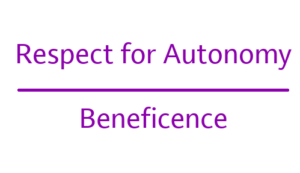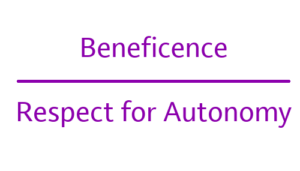Module 2 – Respecting Patient Rights
Module 2 Learning Objectives
While the aim of healthcare is to promote patient well-being, most agree that healthcare providers also have an obligation to respect the values and choices of their patients. However, ethical issues can arise when a patient’s choices appear imprudent from a health perspective or when a patient lacks the ability to make decisions about their medical care. This module will focus on conflicts between promoting patient well-being and respecting patient decisions, as well as thinking about what should be done when a patient is unable to communicate or to make healthcare decisions.
Upon completing the Module 2 reading, you should be able to:
- Define the bioethical principle of respect for autonomy
- Describe the capacity assessment criteria
- Detail the role of a surrogate decision-maker
- Discuss the concept of medical paternalism
Module 2 Table of Contents / Section Jump Links:
2.1) The Principle of Respect for Autonomy
Module 2 Introduction
Now that we have an understanding of how to calculate the net-benefit by assessing relevant benefits and harms, and how to justify a recommendation using the bioethical principles of beneficence and non-maleficence, the next step is to think about the complexities that can arise when actually presenting patients with treatment recommendations. For example, take a moment to puzzle about the following questions:
- Can a patient reject a healthcare provider’s recommendations? When presented with treatment options, does a patient have to agree to at least some of the recommendations provided? What happens if a patient tries to refuse every recommendation? Does it make a difference if the medical recommendations are about life-saving care for the patient?
- How do you know if a patient can make medical decisions? How does a healthcare provider determine whether a patient is able to make their own medical decisions? Under what circumstances might a patient be unable to make decisions? Does it make a difference if the healthcare provider disagrees with the patient’s decision or their reasoning for a decision?
- What happens if a patient is unable to make their own medical decisions? How should a healthcare provider proceed when a patient is unable to communicate or to make decisions about their own care? Does consent still matter, and if so, who has the authority to consent to care on the patient’s behalf? Should patients’ non-health goals and values still be taken into account when they are unable to communicate or decide for themselves?
To help you understand how to work through these and other related questions, this module will introduce you to the bioethical principle of “respect for autonomy” (sometimes referred to as “respect for patient autonomy” or “respect for persons”). The idea behind this third bioethical principle is that people have the right to self-determine and direct their own lives to the extent that they are able. In a healthcare context, this often involves the right of patients to make decisions about the healthcare they receive.
2.1) The Principle of Respect for Autonomy
It is the job of the medical professional to assess patient needs, provide recommendations, and deliver appropriate care; however, in most circumstances the patient reserves the right to make the final decision about the healthcare they receive because of their autonomy. Individuals have “autonomy” and are considered “autonomous” to the extent that they have the rational capacity to self-determine. The word “autonomous” literally translates to self-governing; for example, self-driving cars are also referred to as “autonomous vehicles” because they are not being controlled by anyone. Autonomous organizations are independent and self-governing organizations not beholden to anyone else. And similarly, autonomous individuals have the power to make decisions about how to live their own lives based on their unique goals, values, beliefs, and preferences.
 In the United States, the autonomy of adults is often secured by legal rights, such as the unalienable rights of “life, liberty, and the pursuit of happiness” and the freedoms of religion & expression protected by US Constitution.[1] Protecting people’s autonomy is important because not all people share the same beliefs, values, perspectives, preferences, or goals. For example, I greatly value being a philosopher & college professor, meaning many of preferences and choices are shaped by this goal. But you probably feel differently and would be unhappy if someone forced you to become a college professor, rather than allowing you to discover and pursue your own interests & goals. Or imagine if you were always forced to eat your least favorite food, or to watch shows and movies that you didn’t enjoy. You probably wouldn’t be very happy if other people could always force their preferences on you instead of respecting what you like. And similarly, others wouldn’t be very happy if their preferences were never respected and could only do what you liked. The bioethical principle of “respect for autonomy” is what helps us to acknowledge that it is okay for different people to want and value different things, and that we shouldn’t impose our wants and values on others by limiting their rights to make their own choices.
In the United States, the autonomy of adults is often secured by legal rights, such as the unalienable rights of “life, liberty, and the pursuit of happiness” and the freedoms of religion & expression protected by US Constitution.[1] Protecting people’s autonomy is important because not all people share the same beliefs, values, perspectives, preferences, or goals. For example, I greatly value being a philosopher & college professor, meaning many of preferences and choices are shaped by this goal. But you probably feel differently and would be unhappy if someone forced you to become a college professor, rather than allowing you to discover and pursue your own interests & goals. Or imagine if you were always forced to eat your least favorite food, or to watch shows and movies that you didn’t enjoy. You probably wouldn’t be very happy if other people could always force their preferences on you instead of respecting what you like. And similarly, others wouldn’t be very happy if their preferences were never respected and could only do what you liked. The bioethical principle of “respect for autonomy” is what helps us to acknowledge that it is okay for different people to want and value different things, and that we shouldn’t impose our wants and values on others by limiting their rights to make their own choices.
The Principle of Respect for Autonomy
The principle of respect for autonomy represents a duty to respect the choices of autonomous individuals by allowing patients to freely make decisions about the healthcare they receive.
When prioritizing the principle of respect for autonomy, healthcare providers should allow patients to exercise their capacity for self-determination to the extent that they are capable, and should refrain from constraining or overriding the decisions of their patients.
Just like our previous two principles, the principle of respect for autonomy is a fundamental idea within common morality, It is simply the idea that we owe others due respect given their inherent value and worth as human beings, and showing respect means allowing others to make their own choices. While there is general agreement about the importance of respecting the rights of others, there can sometimes be disagreements over what it means to show someone “proper respect.” For example, some philosophers argue that showing “proper respect” involves actively helping others to achieve their goals. The requirement to assist others in exercising their rights is referred to as a “positive duty,” and often raises further questions about how far this assistance extends.[2] Other philosophers contend that showing “proper respect” simply requires not interfering with another person’s ability to exercise their rights or to achieve their goals. The freedom from interference is referred to as “negative liberty” and is the simplest and most common way to interpret the principle of respect for autonomy.[3] For now, we will focus on the principle of respect for autonomy as only involving a negative liberty, meaning it confers duty not to interfere with patients’ abilities to make their own choices. In the next module (Module 3), we will then consider some positive duties related to respect for autonomy in relation to common requirements to provide information when obtaining informed consent.
Fully prioritizing the principle for respect for autonomy means that all patient refusals of care should be respected. But because we are understanding respect for autonomy as a “negative liberty” that only requires non-inference, this does not necessarily imply the same thing with regard to patient requests for care. Namely, respecting patient autonomy allows the patient to choose freely among the options provided, or to decline all of the options presented, but it does not necessarily entitle a patient to request or receive an option that is likely to cause more harm than benefit. This is because providers still have a professional duty to ensure that any action they take is likely to result in a net-benefit to the patient (as discussed in Module 1, Sec. 1.4). So if a patient with a broken ankle requests chemotherapy because they mistakenly believe it will help to health their ankle faster, the principle of respect for autonomy does not require any healthcare provider to administer chemotherapy because the medical science is clear that chemotherapy will not produce a net-benefit in that situation. What the principle of respect for autonomy does require is that no healthcare provider can take steps to treat the patient’s ankle until the patient has provided consent for those treatments, and to allow the patient to refuse any or all treatments that they do not want.

This isn’t to say that a patient’s treatment preferences should be entirely ignored when making a recommendation. The previous module drew a distinction between health related and non-health related benefits and harms (see Module 1, Sec. 1.1), and recognizing the importance of patient autonomy is one way of incorporating non-health related benefits and harms into our thinking. While respecting a patient’s autonomy can be as minimal as respecting their right to refuse certain care, a more robust way to think about respecting patient autonomy is to take the time to learn about who the patient is as a person, such as asking about their general concerns and goals of care. The more you know about a patient and their unique circumstances, the more you can tailor your recommendations to better fit their needs. In many cases, there can be several different treatment options that would each provide a net-benefit for a patient, though perhaps to varying degrees. Knowing about a patient’s concerns and goals of care can help with matching the patient to a particular option, avoiding a particular option, or having a productive discussion with the patient about necessary trade-offs between promoting their health and meeting their non-health goals of care. In this way, placing an emphasis on the importance of patient autonomy can help with incorporating non-health benefits & harms when determining which of several treatment options to recommend or allow a provider to rule out possible recommendations based on the concerns patients have.
Ms. Greenwood meets with her cardiologist, Dr. Sun, to discuss the treatment options for her Class II congestive heart failure (CHF). Dr. Sun explains that there are three main treatment options that would each help to improve her condition: medical management (drug therapy) which does not involve surgery, an angioplasty with stent placement involving minor surgery, or a coronary artery bypass graft surgery (CABG) which would involve major open heart surgery.
Ms. Greenwood feels a bit overwhelmed with this information and asks “Dr. Sun, which option would you recommend?” Dr. Sun starts off by saying, “given that the longer-term survival rates for Class II CHF are quite similar between patients who undergo a CABG and those who receive a stent, I would start off with the less risky surgery.” Her cardiologist is making this recommendation based on their calculation of the expected net-benefit for Ms. Greenwood. Dr. Sun then continues, “but you could also start out by trying medical management, and if you’re lucky, you might be able to avoid surgery entirely.” Ms. Greenwood still feels a bit confused and asks, “so which are you recommending?”
“Well, that in part depends on what type of relief you’re looking for and how active you are. What are your main concerns about living with CHF long-term?” Dr. Sun asks. This example helps to illustrate that although there are three options that could each provide a net-benefit, determining which is the best option for the patient can depend both on the patient’s health condition and also the patient’s goals for managing their condition. So although a provider will often have an initial idea of what to recommend from a strictly health perspective, by having these types of conversations with patients, providers can also start to incorporate considerations of non-health related benefits and harms into their recommendations.
One last thing to note is that healthcare provides also have what is referred to as “professional autonomy.” This is the idea that highly trained professionals in their fields (doctors, nurses, lawyers, professors, engineers, etc.) have the ability and authority to make judgements about how to do their jobs appropriately without seeking approval from those above them. This allows professionals to make timely decisions about complex issues or cases without waiting on others, so positions with high degrees of professional autonomy often require a significant amount of education, training, licensing, and or certification to ensure that those individuals are capable of navigating nuanced situations. In healthcare, an example of having professional autonomy is the ability of a provider to regularly diagnose and treat patients without “consulting their boss” or “getting approval from a superior” each time.
Within nursing there are varying degrees of professional autonomy. For example, nursing roles that require the least amount of training such as “Licensed Practical Nurses” (LPNs) often report to a manager or supervisor, nurses with more training such as “Registered Nurses” (RNs) often collaborate alongside physicians, and nurses with more extensive training such as “Nurse Practitioners” (NPs) can diagnose and treat patients without regular oversight. Physicians have an even greater degree of professional autonomy, and many even work as independent contractors within a hospital, meaning they don’t even have a “boss” in a typical sense. While conflicts can sometimes arise in relation to a provider’s professional autonomy, these conflicts are less common than the issues that tend to arise with regard to patient autonomy, so the focus of this module will be on the healthcare provider’s duty to respect the autonomy of their patients.
2.2) Patient Decision-Making
Most individuals are legally competent adults with the capacity to make substantially autonomous decisions, and the principle of respect for autonomy tells us to respect the choices of such patients. While respecting autonomy might sound simple, sometimes patients make choices that we highly disagree with, and other times patients might lack the ability to meaningfully make decisions for themselves. To know when and how to respect patient autonomy, healthcare providers must first be able to determine whether a particular patient has the capacity to make substantially autonomous decisions, or the extent to which a patient may temporarily or permanently lack the ability to make autonomous decisions.
While most patients are typically able to make meaningful decisions about how to live their lives (meaning they are substantially autonomous), some patients might temporarily lack the ability to make meaningful decisions due to situational factors. For example, a patient might be in a temporary coma, experiencing the after-effects of anesthesia, recovering from a stroke or traumatic brain injury, or experiencing temporary delirium due to an underlying illness or environmental factors. Yet other patients might even permanently lack the ability to make decisions about their lives (meaning that they are substantially non-autonomous). For example, patients with irreversible brain damage, considerable developmental delays, advanced dementia, or late-stage Alzheimer’s disease.
In the above examples, the factors that limit a patient’s ability to make autonomous decisions, such as dementia or a traumatic brain injury, can be referred to as “internal constraints.” This is because they are internal to the patient (meaning they are affecting the patient’s cognitive abilities) and they constrain the patient’s ability to process information or think clearly. Internal constraints can be temporary if the individual is expected to regain their capacity to make autonomous decisions at some point in the future, or permanent if the individual is never expected to become substantially autonomous.
Permanent Inability to Make Decisions:
Perhaps counterintuitively, cases wherein the patient is permanently non-autonomous are generally less complicated than cases wherein the patient temporarily lacks autonomy. Individuals who are permanently non-autonomous are referred to as “incompetent” following a formal assessment. People often throw around the word incompetent, saying things such as “Bill is incompetent at his job.” In this context, they mean that Bill is very bad at his job. However, in a healthcare context, the words “competency” and “incompetency” have very technical meaning that denote legal designations. Competence denotes that the individual is a legal adult capable of managing their own affairs, while incompetence denotes that the individual has a global cognitive impairment that makes them incapable to managing their own affairs.
In the United States, when a minor turns 18 years old, they automatically become a legally competent adult in the eyes of the law. This entitles them to new rights that they previously did not possess, such as the right to gamble, the right to sign contracts (such as a lease agreement or a loan), and the right to make medical decisions for themselves without requiring the involvement of a parent or guardian. Want to get a tattoo, take out a car loan, gamble away all your money, or rent your own studio apartment? Once you turn 18, you can legally do these things even if your parents don’t want you to!
 However, some adults have a global cognitive impairment, meaning they permanently lack the ability make substantially autonomous decisions and are unable to live independently or manage their own affairs. In these cases, the individual typically undergoes a competency hearing with a local probate court so that a judge can determine whether the individual is sufficiently autonomous and capable of making their own decisions, or whether they are permanently incapacitated and should be declared legally incompetent.
However, some adults have a global cognitive impairment, meaning they permanently lack the ability make substantially autonomous decisions and are unable to live independently or manage their own affairs. In these cases, the individual typically undergoes a competency hearing with a local probate court so that a judge can determine whether the individual is sufficiently autonomous and capable of making their own decisions, or whether they are permanently incapacitated and should be declared legally incompetent.
Depending on the situation, medical providers may be asked to present evidence to assist with these competency determinations. If an individual is declared legally incompetent, they permanently lose the right to make their own legally binding decisions, including medical decisions, and are instead appointed a legal guardian to make decisions and consent on their behalf. Much like a ten-year-old needs to “get permission from a parent or guardian” before going on a field trip, incompetent individuals need the consent of their guardian for any major decision. The court appointed guardian can either be a family member or an independent professional, and their job is to take the incompetent person’s preferences into account as much as possible while trying to promote their well-being. Because guardians are granted the legal authority to make healthcare decisions for incompetent patients, cases involving incompetent individuals often have a clear decision-maker in place and are fairly straightforward.
Temporary Inability to Make Decisions:
The previous discussion only applies to a small number of patients, given that the vast majority of patients are legally competent adults who have the right to make their own healthcare decisions. When a patient is legally competent and fully capable of making their own autonomous decisions, they are referred to as “having decision-making capacity.” This is the ideal situation! Unfortunately, not all competent patients are always capable of making substantially autonomous decisions. As previously discussed, there are any number of internal constraints that could temporarily diminish a patient’s ability to make decisions.
If a patient is legally competent but temporarily unable to make decisions, it would be inaccurate to describe the patient as being “incompetent” because that would suggest the patient is permanently and legally unable to ever make decisions. So instead, a patient who temporarily lacks the ability to make decisions is referred to as “lacking decision-making capacity,” denoting that the patient is a legally competent adult who is currently unable to make autonomous decisions but also expected to regain their decision-making capacity at some point in the future. It might take the patient a few hours, a few days, a few weeks, or in some cases even a few months to fully regain their decision-making capacity. The timeframe does not make a significant difference, so long as there is a reasonable expectation that the patient is likely to regain their ability to make autonomous decisions at some point in the future (this is what distinguishes an internal constraint as being temporary rather than permanent).
 Determinations of capacity are always situational. Just because a patient had decision-making capacity yesterday doesn’t guarantee they still have capacity today or that they will have it tomorrow. This is because medical circumstances can quickly change and affect that patient’s capacity to make decisions. To complicate things further, a patient may sometimes have the capacity for a relatively straightforward decision, such as agreeing to a saline IV, yet simultaneously be unable to make a more complex decision such as whether to undergo thoracic surgery. Rather than being “all or nothing,” decision-making capacity exists on a continuum and refers to the patient’s ability to meaningfully engage with a particular decision. So, for each new decision that comes up, a healthcare provider needs to ensure that the patient has an appropriate level of decision-making capacity for making that decision.
Determinations of capacity are always situational. Just because a patient had decision-making capacity yesterday doesn’t guarantee they still have capacity today or that they will have it tomorrow. This is because medical circumstances can quickly change and affect that patient’s capacity to make decisions. To complicate things further, a patient may sometimes have the capacity for a relatively straightforward decision, such as agreeing to a saline IV, yet simultaneously be unable to make a more complex decision such as whether to undergo thoracic surgery. Rather than being “all or nothing,” decision-making capacity exists on a continuum and refers to the patient’s ability to meaningfully engage with a particular decision. So, for each new decision that comes up, a healthcare provider needs to ensure that the patient has an appropriate level of decision-making capacity for making that decision.
So how does a provider determine if a patient currently has or lacks the capacity to make a specific decision? As a general rule of thumb, if a patient is able to have a productive conversation about their care without raising any concerns, a formal assessment of their capacity likely does not need to be performed. However, not every patient who is alert and oriented to who they are, where they are, the current day/time, and their medical situation (aka, being “AOx4”) has decision-making capacity. If there is even a slight concern about the patient’s ability to reason, engage, or process information, a formal evaluation of the patient’s capacity should be performed and documented in their chart.[4] Clinical psychologists, attending physicians, and clinical ethicists can all be trained to perform formal “capacity assessments” which commonly use four criteria aimed at determining whether the patient 1) can understand relevant medical information, 2) clearly communicate their choice and reasoning, 3) meaningfully appreciates the likely consequences of their choice, 4) and provides a clear rationale for their decision.[5]
Because a patient’s capacity exists on a continuum rather than having a clear “yes” or “no” answer, in order to assess a patient’s decision-making capacity, healthcare providers must make judgements about the degree to which the patients either satisfies or fails to meaningfully satisfy the following criteria:
- Assessing the degree to which a patient understands information is perhaps one of the easiest, because it mostly requires that the patient can engage in a factual conversation about their diagnosis and any recommendations. If the patient is unable to repeat back relevant medical facts, accurately describe their medical diagnosis, or explain what the treatment options mean, it calls into question how much the patient really understands about their condition or the medical decisions before them.
- Assessing the degree to which a patient can make and communicate a choice is sometimes a little less straightforward. If a patient is completely unable or unwilling to communicate their decision, this both calls into question their capacity and often stops any further actions from being taken. However, some patients may have the capacity to make choices yet lack the means to clearly communicate, such as patients who do not speak English or patients with dysarthria (weakened muscles resulting in slowed or slurred speech). If a patient appears alert and attempting to communicate, varying forms of communication should be attempted as needed. Conversely, a patient may be able to state a choice even if they lack the capacity to fully understand that choice. For example, a patient may be able to “parrot back” an option that has been presented without meaningfully understanding.
- Assessing whether a patient appreciates the likely consequence of their choice is still more challenging because it requires the patient to meaningfully acknowledge the consequences and consider what they would mean for their life. This requires the patient to not only be aware of the likely benefits and harms of the choice, but also to think about what their life might look like as a result of these. However, the degree to which a patient really thinks things through can be hard to judge. Importantly, “appreciate” in this context means to “feel the full force” of something and does not necessarily mean that they like or want that thing.
- Assessing a patient’s rationale for their choice is perhaps the most important criteria. This is because the “rationale” is the reason the person gives for their decision. A patient’s rationale is a demonstration that they are able to appropriately process and reason through the situation, meaning their rationale should be grounded in the reality of their situation and help to explain or make sense of the decision they are making. Importantly, the provider does not need to personally or even professionally agree with the patient’s choice or rationale for this criterion to be met. Given that different people have different preferences, beliefs, goals, and values, a provider might not “get” where a patient is coming from and could even be tempted to describe their reasoning as “irrational.” For example, members of the Jehovah’s Witness faith often refuse blood transfusions based on their interpretation of the bible, some patients refuse or delay necessary surgery out of fear of anesthesia or post-surgical discomfort, and yet others patients refuse care simply because they would rather go home than stay in the hospital another day. These may seem like unusual or even bad reasons to refuse essential medical care. But so long as the patient can clearly explain how their decision relates to their personal beliefs, goals, values, etc. and medical circumstances, then this demonstrates that they have a rationale regardless of whether anyone else agrees with their reasons or decision.
Not all of the above criteria need to be fully satisfied in order to deem a patient as having decision-making capacity. This is simply what it means for capacity to “exist on a continuum.” Some patients may understand medical information better than others, or it might be unclear to what extent a patient has meaningfully considered and appreciated the consequences of their decision. And most people do not have perfect decision-making capacity at the best of times (we’ve all done things on auto-pilot or when we’re too tired to think straight), while illness and anxiety can further diminish a patient’s decision-making capacity when they feel at their worst. But just because a patient isn’t able to perfectly reason through a decision, or just because a patient is making a decision that you don’t agree with or would never make for yourself, are not sufficient reasons to take the decision out of the patient’s hands. A capacity assessment is therefore necessary to demonstrate that the patient substantially lacks the ability to meaningfully reason through the decision by falling significantly short of multiple criteria, thereby concluding that the patient “lacks decision-making capacity” and justifying the removal of the decision from the patient.
2.3) Surrogate Decision-Making
When a patient is assessed to lack decision-making capacity for a particular decision any necessary diagnostic tests, treatments, therapies, or other interventions cannot move forward unless there is an alterative way to obtain consent. Consent is necessary for almost any action a healthcare provider wants to perform, and failing to get consent fails to satisfy the principle of respect for autonomy. Fortunately, instead of simply putting everything on hold when a patient lacks capacity, healthcare providers are able to seek consent from an appropriate substitute decision-maker, often referred to as a “surrogate decision-maker.” In order to satisfy the principle of respect for autonomy, consent for an action must be given by either 1) the patient, 2) a surrogate decision-maker when the patient lacks capacity, or 3) a legal guardian if one has been appointed by a court.
Emergency situations are the one exception if immediate intervention is needed in order to stabilize the patient’s condition. In emergency situations, the provider often does not have time to formally assess the patient’s capacity, to ascertain their wishes, or to have an involved discussion about the decision at hand. This means that considerations of autonomy must be temporarily suspended, because if the patient dies, they will never have the opportunity to be autonomous again. In such situations, healthcare providers are generally permitted to act based on what a reasonable person would likely be willing to consent to (often referred to as the “reasonable person standard) which allows providers to act in a way that is expected to stabilize the patient without seeking consent. However, once the patient has been stabilized, then no further actions can be taken without proper consent. If the patient lacks decision-making capacity following the emergency, then a surrogate decision-maker will be needed to consent on behalf of the patient.
 A surrogate decision-maker fills a similar role to that of a guardian insofar as they are both authorized to make decisions on behalf the patient. However, unlike a guardian who has the permanent authority to make decisions, a surrogate’s authority is temporary and only lasts as long as the patient lacks capacity. As soon as the patient regains capacity, the patient regains the right to make their own healthcare decisions. So how does a surrogate decision-maker get appointed, who is allowed be a surrogate, and what does this role involve?
A surrogate decision-maker fills a similar role to that of a guardian insofar as they are both authorized to make decisions on behalf the patient. However, unlike a guardian who has the permanent authority to make decisions, a surrogate’s authority is temporary and only lasts as long as the patient lacks capacity. As soon as the patient regains capacity, the patient regains the right to make their own healthcare decisions. So how does a surrogate decision-maker get appointed, who is allowed be a surrogate, and what does this role involve?
Who Can Appoint a Surrogate Decision-Maker:
A surrogate decision-maker can be appointed by the medical team or clinical ethicist without the need of a court or any legal proceedings. This is because most states already have clear legal statutes about who can act as a surrogate decision-maker, as discussed below. Sometimes a surrogate will be clearly identifiable because that individual has already been present at the patient’s bedside, while other times the medial team may need to look through the patient’s file in order to identify and attempt to contact an appropriate individual, requesting that they act as a surrogate. However, no person is ever required to become a surrogate decision-maker for another. Even if someone is “next in line” to be the surrogate, if that person doesn’t feel comfortable taking on the role and the relevant responsibilities, they can decline to be a surrogate at which point the medical team will attempt to identify and contact another individual.
As previously mentioned, a surrogate decision-maker is only needed when a patient lacks capacity, and the authority of the surrogate ends as soon as the patient regains capacity. Interestingly, because a surrogate decision-maker is not technically a patient of the healthcare team, the capacity of a surrogate decision-maker cannot be formally assessed by healthcare providers. And many people who agree to become surrogates have never done so before, leaving them unsure about what they should be doing. It is therefore important that the healthcare team and/or ethics department to help support the surrogate in understanding their obligations toward the patient and feeling comfortable making decisions.
Who Can Become a Surrogate Decision-Maker:
While the laws on who can be appointed as a surrogate decision-maker vary by state within the US, over half of the states (including Ohio) require the surrogate to be related to the patient through blood or marriage.[6] This means that in most cases, a long-time domestic partner cannot be appointed as a surrogate decision-maker if the couple is not legally married, and a best friend cannot be appointed as a surrogate decision-maker even if they actually know the patient the best. The exception to this is if the patient has completed formal paperwork prior to losing capacity, such as a Living Will or Advance Directive (more on this in Module 5). This allows the patient to legally name an unrelated individual as their Durable Power of Attorney (DPOA) for healthcare. While similar to a surrogate decision-maker, a DPOA often has more authority because they have been granted the legal right to represent the patient, rather than simply being appointed by default or by a third party (such as the medical team or ethics committee). However, less than a quarter of patients typically complete such paperwork, making surrogate decision-makers much more common.
 Most states also have a designated hierarchy for identifying a surrogate decision-maker, sometimes referred to as a “surrogacy ladder.” The typical hierarchy is spouse, adult children, parents, adult siblings, then the closest adult relative if needed. In Ohio, this hierarchy is only required for decisions involving life-sustaining care, meaning that for non-life-threatening situations the hierarchy does not need to be strictly followed and is up to the discretion of the medical team. If there are multiple people who are next in line to be the surrogate, such as multiple adult children, then a majority consensus must be reached among them if disagreements arise. Namely, a disagreement among family members does not automatically pass decision-making authority down to the next rung of the ladder. Instead, ethics committees and family meetings should help them to reach a consensus.
Most states also have a designated hierarchy for identifying a surrogate decision-maker, sometimes referred to as a “surrogacy ladder.” The typical hierarchy is spouse, adult children, parents, adult siblings, then the closest adult relative if needed. In Ohio, this hierarchy is only required for decisions involving life-sustaining care, meaning that for non-life-threatening situations the hierarchy does not need to be strictly followed and is up to the discretion of the medical team. If there are multiple people who are next in line to be the surrogate, such as multiple adult children, then a majority consensus must be reached among them if disagreements arise. Namely, a disagreement among family members does not automatically pass decision-making authority down to the next rung of the ladder. Instead, ethics committees and family meetings should help them to reach a consensus.
What The Role of “Surrogate Decision-Maker” Involves:
The goal is for the surrogate decision-maker to become the voice of the patient when patients are unable to speak for themselves. This is the best way for a healthcare provider to still respect the autonomy of a patient when that patient is temporarily unable to make decisions or express their treatment preferences. This means that the role of the surrogate is to advocate and consent on behalf of a patient who lacks capacity, based on an understanding of that patient’s unique goals, values, and preferences.
A surrogate decision-maker should start by thinking about who the patient is as a person, such as what they know about the person’s beliefs, goals, values, preferences, etc. This is why a surrogate should ideally be someone who knows the patient well, such as a spouse or other close family member. The surrogate should then communicate these values and preferences to the healthcare team so that the patient’s non-health considerations can also be factored into the net-benefit calculation (as discussed in Module 1, Sec. 1.4). Next comes the hardest part; once the treatment options have been presented, the surrogate decision-maker should set aside their own preferences and only consent to the care that they think the patient would want. Because the goal of the surrogate decision-maker is to help the patient’s autonomy be respected, if the surrogate makes a decision that they think the patient would disagree with, they aren’t really respecting the autonomy of the patient and aren’t being a good surrogate decision-maker.
Acting as a surrogate and respecting the autonomy of the patient is often challenging because it means representing the unique beliefs, goals, and values of the patient, even if you don’t personally share them or agree with them. While it’s hard to watch someone you care about make seemingly imprudent decisions, it’s even more challenging to actively advocate for those choices when you personally disagree with them. For example, if you have a family member who is a Jehovah’s Witness, you will know that part of their belief set means refusing any and all blood products. If you become a surrogate for them, in order to respect their autonomy, you should therefore refuse to consent to any blood products on their behalf (such refusing a blood transfusion for the patient). But what happens if a blood transfusion is important for improving the patient’s condition or even saving their life? Allowing people to make decisions that cut against their medical best interest is the biggest challenge that comes with respecting their autonomy, whether it’s the patient making the decision or a surrogate making it for them. But because the role of the surrogate is to respect and represent the autonomy of the patient, this can sometimes mean refusing essential medical care on behalf of the patient if the patient would refuse it for themselves.
2.4) Medical Paternalism
It is now apparent that healthcare providers can quickly face an ethical dilemma when attempting to promote patient autonomy; the principle of beneficence says that providers should promote the well-being of their patients by offering appropriate care and preventing harm, while the principle of respect for autonomy says that providers should respect the rights of their patients to make their own medical decisions even if it interferes with their ability to promote the patient’s well-being. Consider the fact that some people may refuse certain medical care due to their religious beliefs (such as Jehovah’s Witnesses or Christian Scientists), others may refuse medical care because of their non-health values or preferences (such as patients who think the care is too expensive or time-intensive), and still others may refuse medical care simply because they don’t want to go through the treatments (such as patients who don’t want to experience the significant side-effects of chemotherapy). There are any number of reasons that a patient may refuse the care being offered or recommended to them, so how should healthcare providers respond in these situations? Namely, when beneficence and respect for autonomy conflict, which principle should providers prioritize and which can justifiably be overridden?
As discussed in Module 1, the bioethical principles are prima facie, meaning there is no set hierarchy or ordering to the principles. Providers must therefore make reasoned judgments about which principle(s) to prioritize over others when the principles come into conflict. And just like beneficence and non-maleficence often come into conflict, so do the principles of beneficence and respect for autonomy. Providers must therefore determine which principle, beneficence or respect for autonomy, has more moral weight in these situations to know which principle to prioritize over the other.
 When thinking about giving more moral weight to the principle of respect for autonomy, the same challenges arise as for healthcare providers as for surrogate decision-makers, namely it can be hard and even feel wrong sometimes to respect decisions that you personally disagree with. When healthcare providers take seriously the duty to respect patient autonomy, this means that they need to respect the patient’s choice regardless of the option they end up choosing, because it’s actually about respecting the patient’s right to make their own choice. This can include allowing the patient to choose what you think is a sub-optimal option, such as respecting a patient’s refusal of a potentially life-saving blood transfusion. This would be examples of prioritizing respect for autonomy over beneficence.
When thinking about giving more moral weight to the principle of respect for autonomy, the same challenges arise as for healthcare providers as for surrogate decision-makers, namely it can be hard and even feel wrong sometimes to respect decisions that you personally disagree with. When healthcare providers take seriously the duty to respect patient autonomy, this means that they need to respect the patient’s choice regardless of the option they end up choosing, because it’s actually about respecting the patient’s right to make their own choice. This can include allowing the patient to choose what you think is a sub-optimal option, such as respecting a patient’s refusal of a potentially life-saving blood transfusion. This would be examples of prioritizing respect for autonomy over beneficence.But you might be thinking, “is it really okay for a provider to allow a patient to refuse all life-saving care? Isn’t the point of healthcare to try and save patient’s lives?” As we can see in the above example, prioritizing the principle of respect for autonomy over beneficence might sometimes allow the patient to die, yet that seems to go against the goals of healthcare, especially when the patient’s life could possibly be saved by performing one of the options that was refused. So when it comes to life-saving care, we might instead consider prioritizing beneficence over respect for autonomy.
 When thinking about giving more moral weight to the principle of beneficence, healthcare providers are using their medical expertise to determine which treatment options would be most likely to improve the patient’s health, and are making the judgement that the promotion of the patient’s health is more important than prioritizing non-health benefits or respecting the patent’s autonomous right to make their own medical choices. When someone overrides the values or choices of another individual for that individual’s own benefit, it is referred to as an instance of “paternalism.” For example, if a medical provider prioritizes the principle of beneficence over respect for autonomy by giving a patient a life-saving blood transfusion against the patient’s wishes, it is referred to as “medical paternalism.”
When thinking about giving more moral weight to the principle of beneficence, healthcare providers are using their medical expertise to determine which treatment options would be most likely to improve the patient’s health, and are making the judgement that the promotion of the patient’s health is more important than prioritizing non-health benefits or respecting the patent’s autonomous right to make their own medical choices. When someone overrides the values or choices of another individual for that individual’s own benefit, it is referred to as an instance of “paternalism.” For example, if a medical provider prioritizes the principle of beneficence over respect for autonomy by giving a patient a life-saving blood transfusion against the patient’s wishes, it is referred to as “medical paternalism.”When we prioritize beneficence over respect for autonomy, we are acting paternalistically by limiting the person’s right to freely choose (overriding their decision-making abilities) in order to try and benefit that patient. When a healthcare provider acts paternalistically toward a patient in a healthcare context, it is referred to as “medical paternalism.” When one person acts paternalistically toward another, the person acting paternalistically is making a judgement about what they think will best promote the other person’s well-being, even if that other person disagrees. In essence, it is saying “I know what is best for you better than you do.”
 A common example of paternalism is parenthood. Parents frequently have to tell their children “no” and make them do things they don’t want to, like eating their vegetables instead of skipping straight to dessert. And even as children get older and gain more autonomy, their parents still have to tell them “no” sometimes in order to protect their health and well-being (“No, Johnny, you cannot go to Devon’s party if his parents will be out of town.”) In fact, the root of the word paternalism, “pater,” is the Latin word for “father.” This is why your father’s parents are called your “paternal” grandparents. Historically, fathers have been at the top of familial hierarchies which puts them in a position of power to dictate over others, and paternalism is an example of this power that can exist within or outside of families. However, knowing all this still leaves an open question of whether it is ever appropriate for one adult to override the wishes of another in same the way a parent would a child.
A common example of paternalism is parenthood. Parents frequently have to tell their children “no” and make them do things they don’t want to, like eating their vegetables instead of skipping straight to dessert. And even as children get older and gain more autonomy, their parents still have to tell them “no” sometimes in order to protect their health and well-being (“No, Johnny, you cannot go to Devon’s party if his parents will be out of town.”) In fact, the root of the word paternalism, “pater,” is the Latin word for “father.” This is why your father’s parents are called your “paternal” grandparents. Historically, fathers have been at the top of familial hierarchies which puts them in a position of power to dictate over others, and paternalism is an example of this power that can exist within or outside of families. However, knowing all this still leaves an open question of whether it is ever appropriate for one adult to override the wishes of another in same the way a parent would a child.
The last thing to clarify is the difference between paternalism and another seemingly similar moral concept called “the harm principle.” The harm principle says that people should be fully fee to express their autonomy unless their actions threaten harm to others.[7] This underscores the importance of respect for autonomy while placing an important limit on personal autonomy; namely, when it threatens the well-being of other people. The harm principle is what helps to explain why certain hazardous behaviors that threaten the lives of others are illegal, such as drunk driving or distracted driving, while other hazardous behaviors that only endanger yourself are legal, such as skydiving or base jumping. Paternalism is different from the harm principle because paternalism it isn’t about protecting other people from the person acting, it’s about trying to protect the very person who is performing the action! An example of paternalism would be making skydiving or base jumping illegal in order to try and protect the safety of people who are into extreme sports by stopping them from doing those activities.
Medicine has historically been very paternalistic (informed consent requirements only became common in US Healthcare starting in the 1970’s)[8] but is considerably less paternalistic today. However, questions still remain about when (if ever) medical paternalism is appropriate in a healthcare context. As was noted at the beginning of this reading, the culture and laws in the United States lean heavily toward promoting and protecting individual freedoms, placing a significant emphasis on the importance of respect for autonomy. Yet at the same time, certain laws and cultural norms appear to limit personal autonomy in an arguably paternalistic manner including mandatory seatbelt and helmet laws, the criminalization of certain activities such as recreational drug use or prostitution, and “sin taxes” aimed at curbing the purchase of harmful substances such as alcohol and tobacco. This means that when weighing the bioethical principles and considering the merits of prioritizing either beneficence or respect for autonomy, we need to think deeply about what makes respecting the liberties and choices of others so significant, and when (if ever) those choices should be overridden for that individual’s medical benefit.
Module 2 Key Concepts & Takeaways
You should now be able to answer the following questions:
- What does it mean for a person to have autonomy or to be autonomous?
- What does the principle of respect for autonomy say we should do?
- What is the aim when prioritizing the principle of respect for autonomy?
- What is an internal constraint on autonomy and what are some examples?
- What are the key differences between patient capacity and competency?
- What are the criteria used to assess a patient’s decision-making capacity?
- What does it mean to describe a patient as lacking decision-making capacity?
- What is the role of a surrogate decision-maker and who can qualify as one?
- What is medical paternalism and how is it different from the harm principle?
Works Cited
- "The Constitution of the United States," Amendment 1. ↵
- Beauchamp, Tom, and James Childress, The Principles of Biomedical Ethics, 6th edition (Oxford: Oxford University Press, 2009), 104. ↵
- Childress, James, “The Place of Autonomy in Bioethics,” Hastings Center Report 20 (1990): 12-17. ↵
- Barstow C, Shahan B, Roberts M. "Evaluating Medical Decision-Making Capacity in Practice." American Family Physician (2018). 98(1): 40-46. PMID: 30215955. ↵
- Appelbaum PS. Clinical practice. "Assessment of patients' competence to consent to treatment." The New England Journal of Medicine (2007). 357(18): 1834-40. doi: 10.1056/NEJMcp074045. PMID: 17978292. ↵
- DeMartino ES, Dudzinski DM, Doyle CK, Sperry BP, Gregory SE, Siegler M, Sulmasy DP, Mueller PS, Kramer DB. "Who Decides When a Patient Can't? Statutes on Alternate Decision Makers." The New England Journal of Medicine (2017). 76(15): 1478-1482. doi: 10.1056/NEJMms1611497. PMID: 28402767. ↵
- Mill, John Stuart. On Liberty. 1895. ↵
- Dolgin, Janet L. "The Legal Development of the Informed Consent Doctrine: Past and Present." Cambridge Quarterly of Healthcare Ethics 19 (2010): 97-109. doi:10.1017/S0963180109990284 ↵

